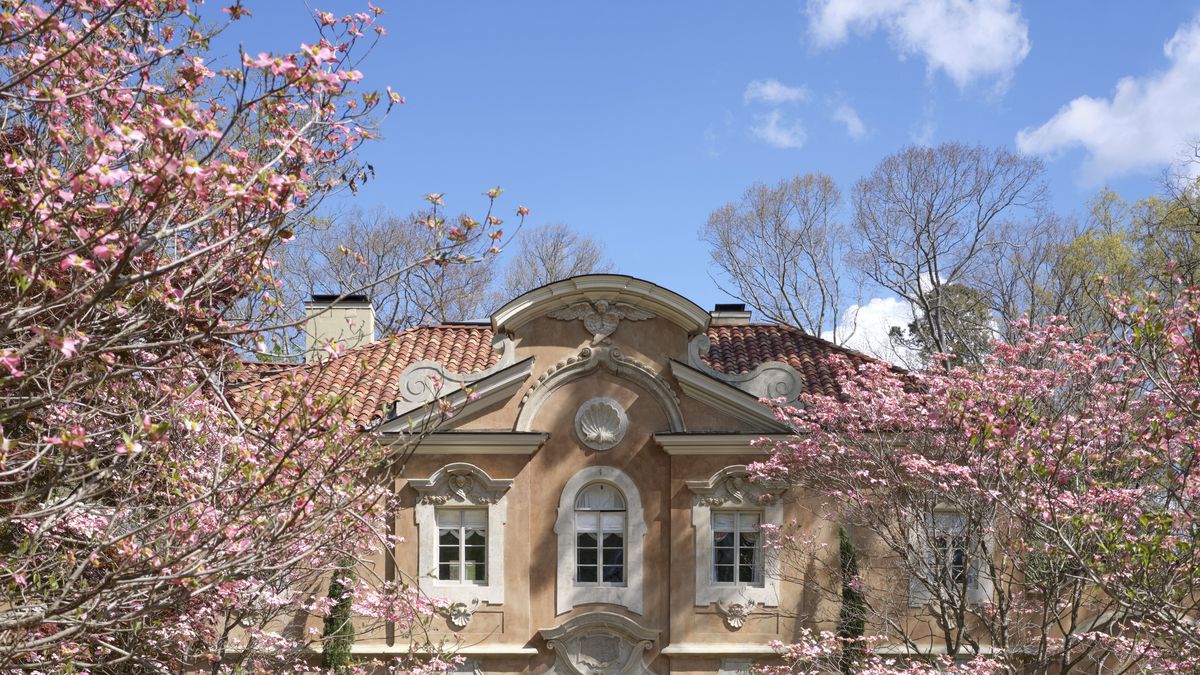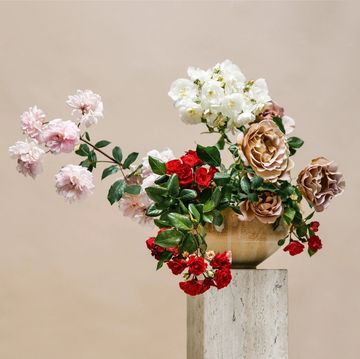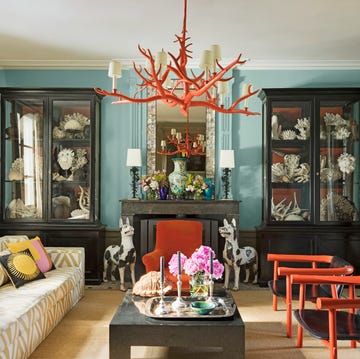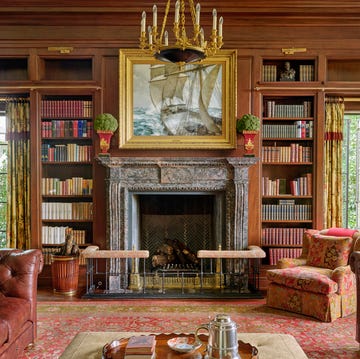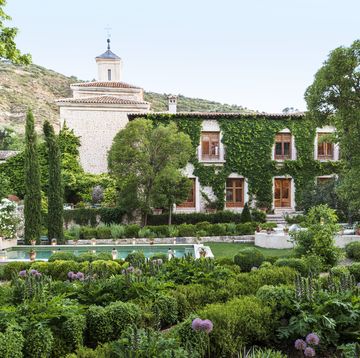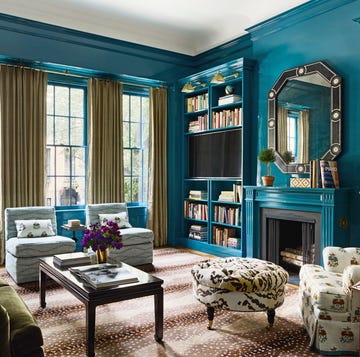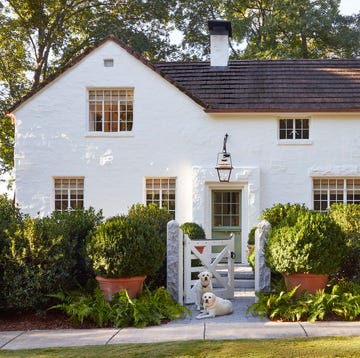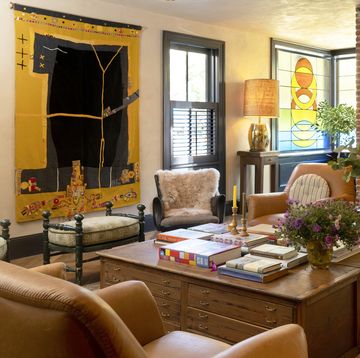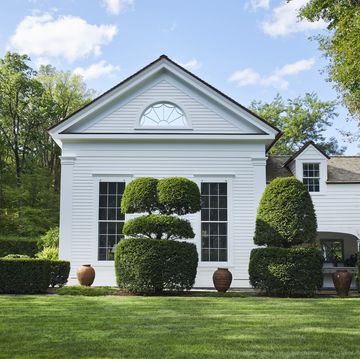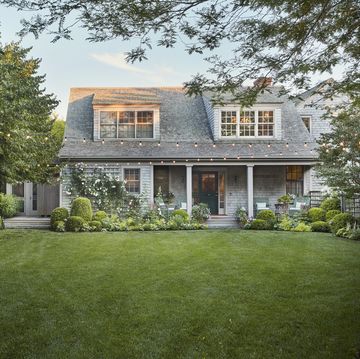“There’s nothing prettier than Atlanta in the spring,” declares interior designer Melanie Turner, who has lived in the city for 45 years. She points to the area of Buckhead around West Paces Ferry Road, where from March to May, glorious blooming dogwoods, azaleas, and redbuds enliven the grounds of some of the city’s most spectacular and historic residences. “It’s just one home after the next that is grand and beautiful,” she says.
One of the neighborhood’s best known and most distinctive residences is a Venetian-style head-turner nicknamed the Pink Palace, owing to its blush-toned stucco facade embellished with winged cherubs, scrolls, shell forms, and other architectural details. Completed in 1926 the house is credited to one of Atlanta’s leading neoclassical architects of the day, Philip Trammell Shutze, who worked closely with Neel Reid at the firm then known as Hentz, Reid & Adler.
When the Pink Palace was on the market several years ago, Turner encouraged Thierry François to give it a serious look. After all François and his wife, Shannon, had expressed admiration for her house, another Shutze creation a mile or so down the road. A pastiche of 16th- and 17th-century Italian villas also with a pink-stucco exterior, it’s notably dubbed the Pink Castle and considered a sister home to the Palace.
“They’re both peacocks,” says Turner, who notes that the similarities have occasionally caused confusion. “When one of us has a party, people will mistakenly show up at my house or show up at that house because they get them mixed up.”
François, for his part, says he had always been intrigued by the Pink Palace, having for years driven past the property, with its long, gently sloping drive bordered by dogwoods. The French-born founder of François & Co.—a 25-year-old company specializing in historically inspired surfaces, antique and architectural stonework, and brass and silver metalwork—acknowledges that the fanciful Italianate style might seem out of place in Atlanta but notes that it has its own kind of authenticity.
Shortly before buying the Pink Palace, François traveled to Venice to find the early 18th-century chapel that served as Shutze’s model. “It has the same facade, same details, even the color,” he says. “Immediately I didn’t feel like this was a house that has no heritage. It was truly well done.”
But over the years alterations had been made, not least covering over the pink stucco with a beigy shade François describes as “khaki pants color.” There was also the addition, from the 1980s, of a two-story garage and guesthouse François says was overscaled and out of character, plus a pool pavilion that further conflicted with the integrity of the original architecture. Among the first things he and his wife did after buying the house was tear down those structures to restore the original footprint. They also brought back the pink facade.
Inside, the changes were arguably even more disconcerting. “Instead of trying to emphasize the beauty and ingenuity of the original house, it seemed that people were trying to hide it,” says François. Not helping matters was the fact that the Pink Palace had hosted decorator showhouses on multiple occasions, meaning rooms were repeatedly revised in ways not always sympathetic to Shutze’s design.
“I took it as a challenge, to show that I could bring this house back and do it right,” says François. At the same time the 12,000-square-foot, five-bedroom residence needed to be a comfortable family home for him and his wife and their four children, who range in age from 12 to 21.
Working hand in hand with Turner, François set about undoing and upgrading. For starters they installed new wood and stone flooring in many of the rooms, replacing granite tiles in the first-floor hallways with warmer and more appropriate Versailles parquet made with reclaimed French oak.
They used the same parquet in the majestic ballroom, conceived by Shutze as the space guests step into when they walk through the front door. The room certainly makes an impression, with its robust Baroque door casings and fireplace surround, complemented by spirited neoclassical hunting scenes painted on linen panels that line the walls.
Adding to the ballroom ambience, Turner found a pair of antique crystal chandeliers in Parma, Italy, while outfitting the room with antique furnishings and artworks the couple already owned, as was the case throughout much of the house. They also installed a grand piano. “My kids and wife like to dance,” François says, “so on many occasions we gather in the ballroom and use it as it was intended.”
In the adjacent sun-splashed conservatory, with multiple French doors that open to the outside, “we tried to make it garden-like,” says Turner, who commissioned painter Bethany Travis of Penshaw Hill to decorate the vaulted ceiling with faux tenting. Turner also covered the original terrazzo floor with a seagrass-woven rug and upholstered all the seating in pale pinks and whites.
The boldest palette in the home appears in the reimagined library, a cozy-chic rhapsody of blues and golds with upholstered walls and scallop-edged curtains. Turner again brought in Travis to paint the room’s barreled ceiling—this time as a cobalt cosmos featuring the zodiacs of everyone in the family. “The library ended up being fantastic,” says François. “When I close the heavy doors, I’m gone—nobody can bother me. It’s a very quiet, warm room, where I personally spend a lot of time.”
Other spaces were given more modest updates, including the dining room, which retains its original wall murals, a series of atmospheric Venetian scenes. Turner had previously worked on the space when she participated in the 2014 edition of the Atlanta Symphony Orchestra Designer Showhouse, and this time around her biggest change was to restore faux marbling to the door and window casings, which had been stripped down to the unfinished pine.
Upstairs Turner transformed the couple’s bedroom into a refuge defined by a very French blue-and-red color scheme and soft textures, anchored by a custom-made bed, with a headboard incorporating antique Italian carved scrollwork. “It’s bright, it’s beautiful,” says the designer, “and it feels like them with an eclectic mix of antiques and new pieces.”
For the three-and-a-half acre grounds, François worked with the landscape design firm Land Plus and Creekside Nurseries, initially to simplify the plan. “It felt claustrophobic when I walked the yard because it had bushes here, a little walkway there, a little sidewall here, a little fence there,” he says. “I cleaned all of it up, opened up the whole yard, and put down sod, so the house is just surrounded by beautiful grass.”
Out front he put in ornamental stonework reclaimed from an Italian estate to accompany a sculptural Baroque entry gate, copied from the one that stands outside the Venetian chapel that inspired the house so long ago. Also he replaced six of the dogwoods bordering the drive, ensuring that each spring a procession of pink would colorfully guide the approach, as if announcing the reinstated majesty of the Pink Palace.
Featured in our May/June 2023 issue. Interior Design by Melanie Turner; Architecture by Philip Trammell; Landscape Design by Land Plus; Photography by Mali Azima; Videography by Jonathan Harper; Styling by Rachael Burrow; Written by Stephen Wallis
